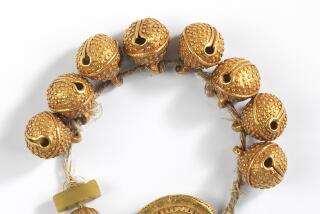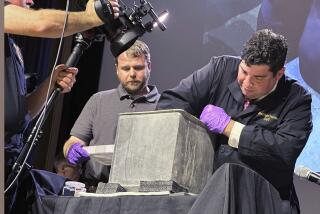New York Works on Recapturing Historic Military Items Gone AWOL
- Share via
WATERVLIET, N.Y. — Col. Elmer Ellsworth was an early martyr for the Union, shot dead on a stairwell moments after plucking an offending Confederate flag from a hotel rooftop in Alexandria, Va.
His Civil War uniform, bullet hole and all, went to New York state’s collection of military artifacts. From there, it was misplaced about a century later--one of many items discovered absent without leave from the collection a few years ago.
A search conducted by the state Division of Military and Naval Affairs has since turned up the colonel’s uniform, along with a number of missing and stolen artifacts. An old cannon was retrieved under a pile of lumber. A pilfered flag plaque from the Spanish-American War was discovered for sale on the Internet. Bit by precious bit, historians and the New York State Police are recovering the pieces and making up for past neglect.
“A lot of places have recently come to realize that this stuff is evaporating on them over the course of time,” said Charles R. Shrader, former executive director of the Society of Military History. “People have come to realize that it is valuable.”
New York’s collection is particularly valuable--more than 100,000 documents and artifacts warehoused in the aged Watervliet Arsenal just north of Albany, and at armories and camps across the state. The collection consists of objects used or acquired by New York’s military units and National Guard, but it encompasses the sweep of American history.
There are Revolutionary-era muskets, a war club wielded by the Seneca chief Cornplanter, recruitment posters from the Civil War era (“Ho! For Dixie”), letters from doughboys, a Nazi antiaircraft helmet, 1,700 battle flags, old artillery shells, a ceremonial sword made by Tiffany and a Nike missile (sans warhead).
“This is the legacy--the birthright--of the people of New York,” said Lt. Col. R. H. Von Hasseln, the state’s director of military history. “It’s their story.”
Von Hasseln means this literally. To him, even a humble helmet tells a tale. He points out a Prussian-style cavalry helmet from 1870 and explains how America still looked to Europe for military cues back then. Then he holds up a modern Kevlar helmet and says some soldiers grumbled when it made its debut because it made a lousy basin for washing socks.
The collection is of incalculable value. Problem was, thieves seemed to appreciate that more than New York. For decades, the collection was itemized on index cards crammed into a shoe box. Delicate historic uniforms were sent out for dry cleaning.
Things just got lost, or were stolen. In one infamous 1975 incident, a state Capitol storage room was broken into and thieves nabbed 23 ceremonial “presentation swords.”
Von Hasseln credits the turnaround to Gov. George Pataki, who has helped secure $800,000 for military preservation projects over six years. The shoe box was replaced with a database, and items were properly tagged. An archivist, librarian and registrar were hired. Administrators around the state were held accountable for the collection’s safety.
The first systemwide check of the holdings continued through 1996, making it clear that many pieces were missing.
Part of the problem was shoddy record-keeping. Ellsworth’s bullet-scarred uniform was located at the Smithsonian. It was loaned out years ago and forgotten. In another case, a cannon fired on state militia troops quelling an 1857 riot by the vicious “Dead Rabbits” New York City street gang was found under a pile of lumber at Camp Smith in Peekskill.
State police were asked to locate items thought to be stolen. Investigators, carving out time between more pressing cases, began the difficult task of tracing trails left cold for years--or decades. Police interviewed one armory custodian from the 1950s in a nursing home. They talked to relatives of dead superintendents.
Slowly they made headway. A missing cannon was found in somebody’s garage. A Civil War recruiting poster was found hanging on an office wall in Washington. Once, after investigators began asking questions about a missing German machine gun from World War I, it suddenly turned up in an armory locker.
“When people notice actual law enforcement is involved, items appear,” said state police Capt. John Byrne.
Investigators last year began attending militaria shows in search of hot goods. The Spanish-American War flag plaque was found during a routine check of Internet auction sites. Investigators made a high “bid” on the item and then went to retrieve the state’s property from a surprised collector on Long Island.
No arrest was made in that case --or any other case yet--because police did not think the circumstances warranted it.
“This gentleman received it from a dealer, who received it from another dealer. It just went on and on,” Byrne said.
The case illustrates the problem the thriving collectibles market poses. Hot items can change hands repeatedly and end up far away. Byrne said two Civil War cannons taken from a memorial in Delaware County were located in Pennsylvania.
David J. Maloney Jr., author of Maloney’s Antiques & Collectibles Resource Directory, said Civil War artifacts in particular are popular, with a more recent surge in items from World War II.
“Unfortunately, the stuff just walks,” he said.
Another vexing problem involves collectors holding tight to goods stolen from the state, either for their private enjoyment or to avoid being caught.
“They put this stuff in the basement and they don’t tell anyone about it,” Von Hasseln said.
Von Hasseln believes the presentation swords might not be recovered until their current holders die. Other items still missing include a keg-like Confederate sea mine and Revolutionary War discharge papers signed by George Washington. Investigators were recently tracking down leads on a missing flag and an artillery piece.
Von Hasseln said no pieces have been stolen since 1995. With the collection being assembled and categorized, he is working on finding a new museum to house it. The current museum in the Watervliet Arsenal is lacking in amenities and is open infrequently.
And Von Hasseln is thinking about the future, historically speaking. He has added a biohazard containment suit to the collection and an MRE--”Meals Ready to Eat” ration. He also persuaded a buddy to donate his old Desert Storm uniform for the collection.
It’s stored safely in the arsenal, and properly tagged.
*
Division of Military and Naval Affairs: https://www.dmna.state.ny.us/
More to Read
Sign up for Essential California
The most important California stories and recommendations in your inbox every morning.
You may occasionally receive promotional content from the Los Angeles Times.













